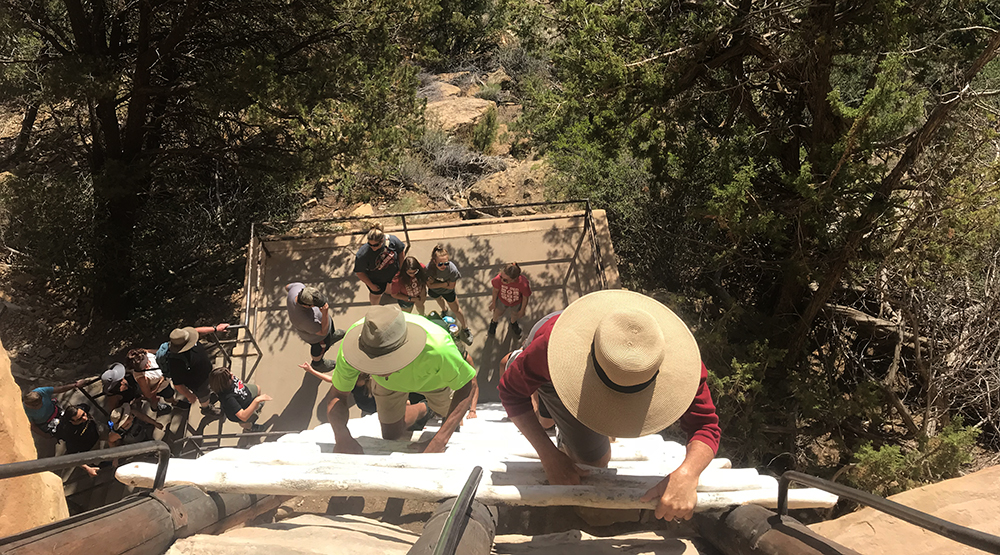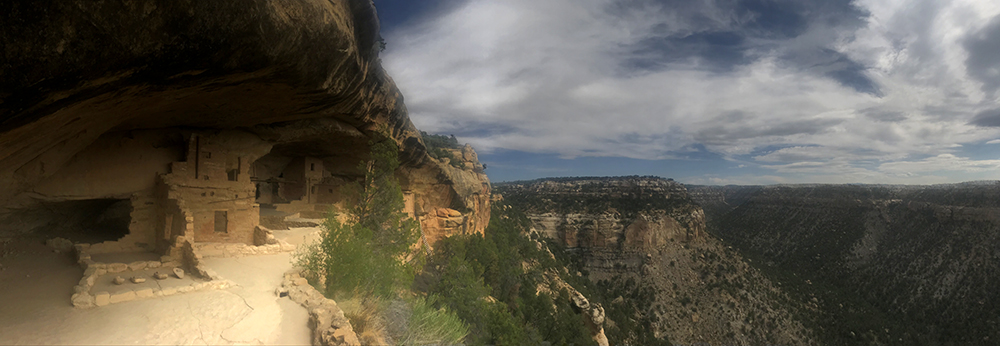Mesa Verde National Park invites guests into the homes of the Ancestral Puebloan people, showcasing the finest in cliff-dwelling construction from the 12th century. An early addition to the national park idea, Mesa Verde holds the largest collection of such structures in the country.

Guide to Mesa Verde
Mesa Verde National Park
Mesa Verde preserves more than 4,700 archeological remains and more than 600 separate cliff dwellings that testify to a once mighty presence, which lasted for more than 700 years, from A.D. 600 to somewhere around 1300.
Originally, the Puebloans lived on the mesa tops in pit-houses or adobe structures, and so they existed in small villages of such modest dwellings for about 600 years. However, in the late 1100s, the people of Mesa Verde began to construct impressive dwellings in the protected overhanging cliffs of the eastern Colorado Plateau.
Most of the cliff dwellings are small in size. Of the 600 dwellings found in the park, 90 percent contain fewer than 10 rooms. Many were probably used as storage facilities, while the larger, more popular structures that are featured in the ranger-led tours often housed more than 100 people.
Where is Mesa Verde?
Mesa Verde National Park is located in southwestern Colorado, in the Four Corners region, about 35 miles west of the town of Durango, and 12 miles east of Cortez. There is one park entrance on Colorado Highway 160.
Stop by the Mesa Verde Visitor and Research Center before driving into the park in order to ask questions, check out the cool exhibits or purchase tickets for the tours of Cliff House, Balcony House or Long House. Tour tickets cannot be purchased at the ruins. Most tours are only available from mid May through October. The park offers little in the way of winter activities.
Exploring Mesa Verde
Nearly all of the park’s attractions are found on Chapin and Wetherill Mesas, which are located about 20 miles south of the park entrance. The drive from the visitor center to these mesas will take a little time, as the route follows a steep, winding road as it makes its way over a series of mesas and canyons.
There are numerous pullouts along the way that showcase views into the four corners region and the Mesa Verde high country.

Far View
Far View provides the first access to ruins for visitors driving into the park. This was an early development for the ancestral Puebloans, as the villages here predate the cliff dwellings by more than 200 years.
The Far View area was heavily populated and scientists have identified nearly 50 villages in the nearby vicinity that were home to hundreds of people. Many of the Far View residents remained here after the cliff dwellings were occupied, suggesting that the area was well suited for habitation.
Today, Far View is home to the park’s only lodging, a pub, and a couple of dining options. See the visiting page for more information on the facilities at Far View.
Chapin Mesa
Chapin Mesa holds the majority of the historic dwellings at Mesa Verde. The mesa reaches southward to the park’s boundary, and the most popular sites can be accessed by a series of three one-way drives that loop around the Spruce House, the Cliff Palace and the Balcony House.
Guests who wish to learn more about the historical aspects of this park should also visit the Chapin Mesa Archeological Museum, which features numerous artifacts that were unearthed from nearby archeological digs.

Tours are available of both Cliff Palace and the Balcony House, and while the Spruce Tree House was once available for self guided tours, it is now closed due to unstable rocks in the cliff above the house.
The Cliff Palace tour is one hour in length, and ushers visitors into a collection of ruins that has more than 150 rooms and 23 kivas – small chambers, usually containing fire rings that were likely used for religious or ceremonial purposes.
Other elaborate structures are found here as well, such as Square Tower House, which stands impressively against a large south-facing cliff and enjoys a fabulous sunset view. This dwelling was built in the mid 1200s and is Mesa Verde’s tallest surviving structure, holding the record of tallest man-made structure in north America until the mid 1800s.
Wetherill Mesa
This is the furthest removed publicly accessible area of the park, and runs parallel to Chapin Mesa, stretching from north to south. Wetherill Mesa is open from late May to early September, and provides access to a few of the park’s less visited sites.
Guests who acquire a tour ticket can explore the Long House, which is the second largest cliff dwelling in the park. It has 150 rooms, 21 kivas and a row of upper storage rooms, and likely provided a home for nearly 175 people. The Long House was only excavated in the late 1950s and early 1960s in a joint effort between the National Park Service and the National Geographic Society.
The area has other structures as well, and its sites can be viewed by hiker and bikers on the Long House Loop Road, a 5-mile paved loop that hits a few cool spots such as the Kodak House Overlook, the Badger House Community and the Nordenskiöld Site #16.
An Abandoned Palace
Mysteriously, not long after the construction of the cliff dwellings, the Puebloans gave up their homes and moved away. It appears that these cliffs provided a home to their inhabitants for less than 150 years, which begs the question: why did they leave?
Although we know roughly when these people left and where they went, we still have not concluded with any degree of certainty, exactly why they left their home.

It is doubtful that their departure was due to conflict, although some of the later-constructed dwellings did seem to have some degree of security in mind when built, due to tight passage-ways and high lookout towers, some with underground tunnels to nearby kivas. For the most part however, it appears that they enjoyed a relatively peaceful existence on the area mesas.
The most likely scenario is drought, combined with a scarcity of resources that resulted from an influx of inhabitants. It is believed that many refuges made their way to Mesa Verde following the collapse of the Chaco Culture to the south in the late 1190s.
With more mouths to feed, a reduction in resources due to a drought would have meant more problematic conditions for the communities. Many scientists theorize that this set of circumstances led to the abandonment of the luxurious cliff dwellings at Mesa Verde sometime just before the year 1300.
These Puebloans did not simply disappear. We know that they spread throughout the desert southwest over the next 800 years and their descendants are found today among at least 14 Puebloan tribes in several southwestern states.
Playtime in Mesa Verde
A visit to Mesa Verde probably won’t suck no matter your itinerary, but there is not much to write home about without an up-close inspection of the cliff-dwellings themselves. Only two of the dwellings, Chapin Mesa’s Spruce House and Wetherill Mesa’s Step House can be entered without embarking on a ranger-led tour. (As of September 2015, Spruce House is closed to public access for the foreseeable future due to rockfall from above the ruin)

Mesa Verde Tours
Ranger-led tours are the only way to gain access to the park’s largest, and most well preserved ruins. Stop by the Mesa Verde Visitor and Research Center before driving into the park in order to purchase tickets for tours of Cliff House, Balcony House or Long House. Tour tickets can also be purchased online. Tours are only available from mid-May through October on both Chapin and Wetherill Mesa.
Chapin Mesa is the more visited of the two and features the park’s most popular tours at Balcony House and Cliff Palace. Tours of both locations are 1 hour in length. Wetherill Mesa is further removed and less visited, yet the 1.5 hour long tour of the Long House makes up for a slightly longer drive.
The park offers tours of a few other lesser-known sites as well, check out the visiting and activities sections to learn more about these options.

Hiking in Mesa Verde
Most of the park’s 52,000 acres are off limits, as off-trail hiking is prohibited and actual trails are few. However, it is possible to find solitude on these trails, as not many people venture out into the Mesa Verde backcountry. During winter, the Cliff Palace Road is not plowed, thus it provides an excellent trail for snowshoeing or cross-country skiing.
Services at Mesa Verde
Lodging is available mid-April through mid-October at the Far View Lodge, which sits at the junction of the roads to Chapin and Wetherill Mesas and dining is available at the Matate Room Restaurant at the Far View Lodge. The Far View Terrace Café and the Spruce House Café offer casual fair and the Far View Lounge can set you up with a well-deserved cocktail after a day in the ruins.
Morefield Campground is just 4 miles inside the park and contains 267 sites that rarely fill. Several hikes depart from here, including the Prater Ridge Trail, an 8-mile loop that features nice views of the surrounding area.
See the visiting page for more information about visiting Mesa Verde National Park.

Park Junkie Verdict
This is a history lover’s park. While the tours of the dwellings are informative and offer admittance to some sacred homes, there is not a lot here in the way of activities to keep one for more than a couple of days… unless of course, mountain biking interests you, in that case, move on in!
Excellent mountain biking trails are found just outside the park in an area known as Phil’s World. See the activities page if you’re interested in shredding some exciting single-track.
For the rest of you, there is great hiking in the surrounding national forests and southwestern Colorado offers endless adventure.
That said, cruise on in and get to know Mesa Verde National Park. Take at least one of the tours and imagine yourself wandering into these sacred dwellings with the Wetherill brothers, more than a century ago…
See ya there…
Guide to Mesa Verde
Relevant Links
National Park Guides

All content found on Park Junkie is meant solely for entertainment purposes and is the copyrighted property of Park Junkie Productions. Unauthorized reproduction is prohibited without the express written consent of Park Junkie Productions.
YOU CAN DIE. Activities pursued within National Park boundaries hold inherent dangers. You are solely responsible for your safety in the outdoors. Park Junkie accepts no responsibility for actions that result in inconveniences, injury or death.
This site is not affiliated with the National Park Service, or any particular park.
